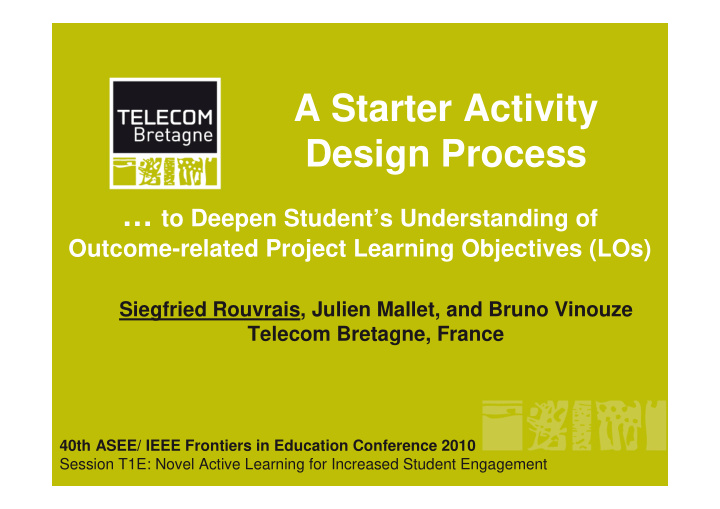



A Starter Activity Design Process … to Deepen Student’s Understanding of Outcome-related Project Learning Objectives (LOs) Siegfried Rouvrais, Julien Mallet, and Bruno Vinouze Telecom Bretagne, France 40th ASEE/ IEEE Frontiers in Education Conference 2010 Session T1E: Novel Active Learning for Increased Student Engagement
Curriculum context � Telecom Bretagne (CDIO collaborator since 2009): • engineering school in 3 years (200 students/year) - French Grande Ecole system, freshmen with very poor prior experience • professional skills are a key goal - PBL since 2003 - 4 semester-projects (approx. 100h/student, teams between 3 to 8) LOs 100h • PBL and teamwork experiences sometimes unsettling - slower project involvement and enthusiasm ASEE/IEEE FIE 2010 “Starter Activity Design Process…” page 1 Session T1E S. Rouvrais, J. Mallet and B. Vinouze
Baseline: student struggle with project LOs � Students do not always early identify and understand the project LO spectrum: • traditional course materials typically list LOs • often not read or understood by learners (not enough concrete experience) ASEE/IEEE FIE 2010 “Starter Activity Design Process…” page 2 Session T1E S. Rouvrais, J. Mallet, and B. Vinouze
Objectives � From the early stages of each project: • to give students a clearer understanding of the skills and abilities they are expected to acquire • so as to participate more actively in their own learning path � Provide some meaning to their studies and learning, sense of responsibility, … engagement ASEE/IEEE FIE 2010 “Starter Activity Design Process…” page 3 Session T1E S. Rouvrais, J. Mallet and B. Vinouze
Approach: short starter activities Proposal: systematic 2h concrete starter experiences: � to help student recognize, via experience and *by • themselves*, the project LOs in the front-end of each project, as “icebreakers, kick- • offs, warm-ups, energizers, brainteasers, etc.” examples: tiny bridge design-build (cf. paper), board • game development and validation (cf. paper), etc. specific LO aligned with the forthcoming project • 100h ASEE/IEEE FIE 2010 “Starter Activity Design Process…” page 4 Session T1E S. Rouvrais, J. Mallet, and B. Vinouze
Bridge example LOs: designing, cost/quality/delay ASEE/IEEE FIE 2010 “Starter Activity Design Process…” page 5 Session T1E S. Rouvrais, J. Mallet, and B. Vinouze
LO: building ASEE/IEEE FIE 2010 “Starter Activity Design Process…” page 6 Session T1E S. Rouvrais, J. Mallet, and B. Vinouze
LO: valorisation ASEE/IEEE FIE 2010 “Starter Activity Design Process…” page 7 Session T1E S. Rouvrais, J. Mallet, and B. Vinouze
A 3 phase process Require coherent treatment throughout the curriculum � educational staff’s skills sometimes heterogeneous • pedagogic responsibilities shared between the 4 • projects LO alignment • Establish guidelines for designing and managing � such short sessions ASEE/IEEE FIE 2010 “Starter Activity Design Process…” page 8 Session T1E S. Rouvrais, J. Mallet, and B. Vinouze
Design phase ASEE/IEEE FIE 2010 “Starter Activity Design Process…” page 9 Session T1E S. Rouvrais, J. Mallet, and B. Vinouze
Deployment phase � Debriefing with an “independent” tutor to shed light to LO and prompt reflection [Schön], abstract conceptualization ASEE/IEEE FIE 2010 “Starter Activity Design Process…” page 10 Session T1E S. Rouvrais, J. Mallet, and B. Vinouze
Improvement phase Supporting the activity effectiveness vis-à-vis project � leaders, essential to manage QA-continual improvement ASEE/IEEE FIE 2010 “Starter Activity Design Process…” page 11 Session T1E S. Rouvrais, J. Mallet, and B. Vinouze
Benefits � If properly designed and deployed: • students more motivated and creative to imprint a team dynamic on the upcoming project • reinforce student self-confidence, self-efficacy: - greater self awareness of his (team) strengths and weaknesses • short term identification and concrete understanding of dedicated LO: - Remembering category [Bloom] generally met, often comprehension • tutors can early point out possible weaknesses within teams to warn the next project instructor ASEE/IEEE FIE 2010 “Starter Activity Design Process…” page 12 Session T1E S. Rouvrais, J. Mallet and B. Vinouze
Limits � Difficulties (students): • number of LO addressed should be limited • analyzing and evaluating categories [Bloom] rarely met • dependant of individual learning preferences [Kolb] (to be taken into account in the process constraints) � Difficulties (tutors): • more acting as observers, strenuous challenge of the reflective debriefing • adjust dynamically the feasibility constraints to galvanize student cognitive obstacles and awareness � A more rigorous analysis now necessary, to objectively assess if LO better perceived, interpreted and understood ASEE/IEEE FIE 2010 “Starter Activity Design Process…” page 13 Session T1E S. Rouvrais, J. Mallet and B. Vinouze
Questions, remarks ? “ A Starter Activity Design Process to Deepen Student’s Understanding of Outcome-related Project Learning Objectives ” ASEE/IEEE FIE 2010 “Starter Activity Design Process…” page 14 Session T1E S. Rouvrais, J. Mallet, and B. Vinouze
Recommend
More recommend